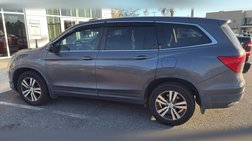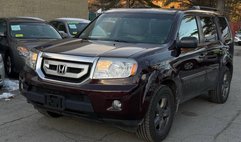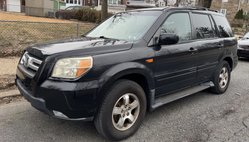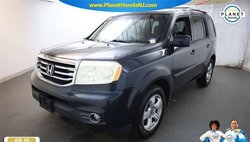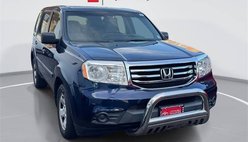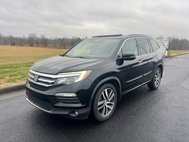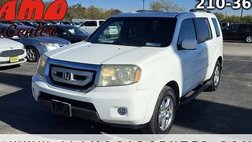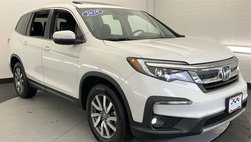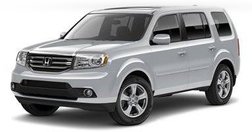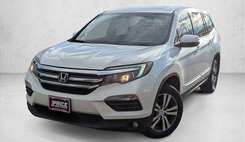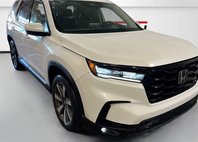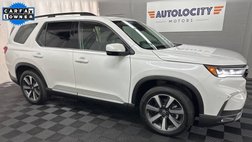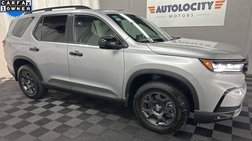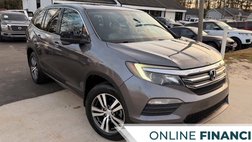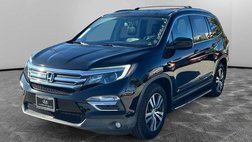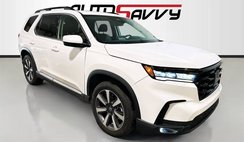
Used Honda Pilot for Sale
Showing 1-20 of 2,887 Listings
Featured
$10,599
$10,7992016 Honda Pilot Touring
- 151,917 Miles
- Lagrange, GA
- Remaining Lifespan: 6.873327 yrs
- $3,652 Below market value of $14,251
- Listed 35 days ago
●
iSeeCars Dealer Score
Used 2016 Honda Pilot Touring for Sale
151,917 Miles
Lagrange, GA
| Category | Used Cars |
| Price | $10,599 |
| For Sale By | dealer |
| iSeeCars Dealer Score | |
| Engine | 6-cylinder |
| Fuel Type | Gas |
| Seats | 8 Seats |
| VIN | 5FNYF5H91GB019279 |
| Location | Lagrange, GA |
| Features | bluetooth, child safety, navigation, backup camera, leather upholstery |
| Mileage | 151,917 mi. |
| Transmission | Automatic |
| Exterior Color | Obsidian blue pearl |
| MPG | 23 combined |
| Drivetrain | Front-wheel drive |
Featured
$10,791
$10,9902018 Honda Pilot EX-L
- 166,189 Miles
- Savannah, GA
- Remaining Lifespan: 7.6296654 yrs
- $3,820 Below market value of $14,611
- Listed 16 days ago
●
iSeeCars Dealer Score
Used 2018 Honda Pilot EX-L for Sale
166,189 Miles
Savannah, GA
| Category | Used Cars |
| Price | $10,791 |
| For Sale By | dealer |
| iSeeCars Dealer Score | |
| Engine | 6-cylinder |
| Fuel Type | Gas |
| Seats | 8 Seats |
| VIN | 5FNYF5H5XJB006390 |
| Location | Savannah, GA |
| Features | bluetooth, child safety, backup camera, leather upholstery, internet radio |
| Mileage | 166,189 mi. |
| Transmission | Automatic |
| Exterior Color | Modern steel metallic |
| Interior Color | Black |
| MPG | 22 combined |
| Drivetrain | Front-wheel drive |
$4,995
2010 Honda Pilot EX-L
- 187,741 Miles
- Cumming, GA
- Remaining Lifespan: 4.488705 yrs
- $1,734 Below market value of $6,729
- Listed 2 days ago
●
iSeeCars Dealer Score
Used 2010 Honda Pilot EX-L for Sale
187,741 Miles
Cumming, GA
| Category | Used Cars |
| Price | $4,995 |
| For Sale By | dealer |
| iSeeCars Dealer Score | |
| Engine | 6-cylinder |
| Fuel Type | Gas |
| Seats | 8 Seats |
| VIN | 5FNYF4H59AB034983 |
| Location | Cumming, GA |
| Features | child safety, backup camera, leather upholstery, sunroof, alloy wheels |
| Mileage | 187,741 mi. |
| Transmission | Automatic |
| Exterior Color | Unknown |
| MPG | 18 combined |
| Drivetrain | 4X4 |
$3,999
2010 Honda Pilot EX-L
- 231,197 Miles
- Ayer, MA
- Remaining Lifespan: 4.488705 yrs
- $1,188 Below market value of $5,187
- Listed 20 days ago
●
iSeeCars Dealer Score
Used 2010 Honda Pilot EX-L for Sale
231,197 Miles
Ayer, MA
| Category | Used Cars |
| Price | $3,999 |
| For Sale By | dealer |
| iSeeCars Dealer Score | |
| Engine | 6-cylinder |
| Fuel Type | Gas |
| Seats | 8 Seats |
| VIN | 5FNYF4H56AB016277 |
| Location | Ayer, MA |
| Features | child safety, backup camera, leather upholstery, sunroof, alloy wheels |
| Mileage | 231,197 mi. |
| Transmission | Automatic |
| Exterior Color | Burgundy |
| Interior Color | Beige |
| MPG | 18 combined |
| Drivetrain | 4X4 |
$5,000
2006 Honda Pilot EX-L w/Navi
- 138,000 Miles
- Philadelphia, PA
- Remaining Lifespan: 4.531997 yrs
- $1,473 Below market value of $6,473
- Listed Today
Used 2006 Honda Pilot EX-L w/Navi for Sale
138,000 Miles
Philadelphia, PA
| Category | Used Cars |
| Price | $5,000 |
| For Sale By | owner |
| Engine | 6-cylinder |
| Fuel Type | Gas |
| Seats | 8 Seats |
| VIN | 2HKYF18776H546055 |
| Location | Philadelphia, PA |
| Features | child safety, navigation, backup camera, leather upholstery, sunroof |
| Mileage | 138,000 mi. |
| Transmission | Automatic |
| Exterior Color | Black |
| MPG | 17 combined |
| Drivetrain | Four-wheel drive |
| Positives | no accidents |
$4,485
$5,5002012 Honda Pilot EX-L
- 204,554 Miles
- Union, NJ
- Remaining Lifespan: 4.5825768 yrs
- $1,335 Below market value of $5,820
- Listed 24 days ago
●
iSeeCars Dealer Score
Used 2012 Honda Pilot EX-L for Sale
204,554 Miles
Union, NJ
| Category | Used Cars |
| Price | $4,485 |
| For Sale By | dealer |
| iSeeCars Dealer Score | |
| Engine | 6-cylinder |
| Fuel Type | Gas |
| Seats | 8 Seats |
| VIN | 5FNYF4H5XCB011635 |
| Location | Union, NJ |
| Features | bluetooth, child safety, backup camera, leather upholstery, sunroof |
| Mileage | 204,554 mi. |
| Transmission | Automatic |
| Exterior Color | Bali blue pearl |
| Interior Color | Gray |
| MPG | 20 combined |
| Drivetrain | 4X4 |
$15,290
$18,7592015 Honda Pilot LX
- 69,808 Miles
- Bronx, NY
- Remaining Lifespan: 4.9053655 yrs
- $4,616 Below market value of $19,906
- Listed 36 days ago
●
iSeeCars Dealer Score
Used 2015 Honda Pilot LX for Sale
69,808 Miles
Bronx, NY
| Category | Used Cars |
| Price | $15,290 |
| For Sale By | dealer |
| iSeeCars Dealer Score | |
| Engine | 6-cylinder |
| Fuel Type | Gas |
| Seats | 8 Seats |
| VIN | 5FNYF4H21FB042427 |
| Location | Bronx, NY |
| Features | bluetooth, child safety, backup camera, power outlet, anti-theft system |
| Mileage | 69,808 mi. |
| Transmission | Automatic |
| Exterior Color | Obsidian blue pearl |
| Interior Color | Gray |
| MPG | 20 combined |
| Drivetrain | 4X4 |
$10,850
2016 Honda Pilot Touring
- 163,646 Miles
- Paducah, KY
- Remaining Lifespan: 6.874307 yrs
- $3,163 Below market value of $14,013
- Listed 6 days ago
●
iSeeCars Dealer Score
Used 2016 Honda Pilot Touring for Sale
163,646 Miles
Paducah, KY
| Category | Used Cars |
| Price | $10,850 |
| For Sale By | dealer |
| iSeeCars Dealer Score | |
| Engine | 6-cylinder |
| Fuel Type | Gas |
| Seats | 8 Seats |
| VIN | 5FNYF5H96GB030035 |
| Location | Paducah, KY |
| Features | bluetooth, child safety, navigation, backup camera, leather upholstery |
| Mileage | 163,646 mi. |
| Transmission | Automatic |
| Exterior Color | Crystal black pearl |
| MPG | 23 combined |
| Drivetrain | Front-wheel drive |
$13,888
2018 Honda Pilot EX-L
- 115,047 Miles
- Rosenberg, TX
- Remaining Lifespan: 7.651634 yrs
- $4,027 Below market value of $17,915
- Listed 30 days ago
●
iSeeCars Dealer Score
Used 2018 Honda Pilot EX-L for Sale
115,047 Miles
Rosenberg, TX
| Category | Used Cars |
| Price | $13,888 |
| For Sale By | dealer |
| iSeeCars Dealer Score | |
| Engine | 6-cylinder |
| Fuel Type | Gas |
| Seats | 8 Seats |
| VIN | 5FNYF5H5XJB014232 |
| Location | Rosenberg, TX |
| Features | bluetooth, child safety, backup camera, leather upholstery, internet radio |
| Mileage | 115,047 mi. |
| Transmission | Automatic |
| Exterior Color | Crystal black pearl |
| Interior Color | Gray |
| MPG | 22 combined |
| Drivetrain | Front-wheel drive |
$4,995
2011 Honda Pilot EX-L
- 212,590 Miles
- San Antonio, TX
- Remaining Lifespan: 4.52667 yrs
- $1,374 Below market value of $6,369
- Listed 23 days ago
●
iSeeCars Dealer Score
Used 2011 Honda Pilot EX-L for Sale
212,590 Miles
San Antonio, TX
| Category | Used Cars |
| Price | $4,995 |
| For Sale By | dealer |
| iSeeCars Dealer Score | |
| Engine | 6-cylinder |
| Fuel Type | Gas |
| Seats | 8 Seats |
| VIN | 5FNYF3H50BB029182 |
| Location | San Antonio, TX |
| Features | child safety, leather upholstery, sunroof, alloy wheels, satellite radio |
| Mileage | 212,590 mi. |
| Transmission | Automatic |
| Exterior Color | Taffeta white |
| Interior Color | Gray |
| MPG | 19 combined |
| Drivetrain | Front-wheel drive |
$16,998
$17,8892020 Honda Pilot EX-L
- 109,832 Miles
- Princeton, NJ
- Remaining Lifespan: 8.646519 yrs
- $4,842 Below market value of $21,840
- Listed 19 days ago
●
iSeeCars Dealer Score
Used 2020 Honda Pilot EX-L for Sale
109,832 Miles
Princeton, NJ
| Category | Used Cars |
| Price | $16,998 |
| For Sale By | dealer |
| iSeeCars Dealer Score | |
| Engine | 6-cylinder |
| Fuel Type | Gas |
| Seats | 8 Seats |
| VIN | 5FNYF6H58LB009345 |
| Location | Princeton, NJ |
| Features | bluetooth, child safety, backup camera, leather upholstery, internet radio |
| Mileage | 109,832 mi. |
| Transmission | Automatic |
| Exterior Color | Platinum white pearl |
| Interior Color | Black |
| MPG | 21 combined |
| Drivetrain | All-wheel drive |
| Positives | inspected, certified pre-owned car, routine maintenance, clean history, warranty, one owner |
$9,791
2012 Honda Pilot EX-L w/DVD
- 94,170 Miles
- Spring, TX
- Remaining Lifespan: 4.582135 yrs
- $2,576 Below market value of $12,367
- Listed 5 days ago
●
iSeeCars Dealer Score
Used 2012 Honda Pilot EX-L w/DVD for Sale
94,170 Miles
Spring, TX
| Category | Used Cars |
| Price | $9,791 |
| For Sale By | dealer |
| iSeeCars Dealer Score | |
| Engine | 6-cylinder |
| Fuel Type | Gas |
| Seats | 8 Seats |
| VIN | 5FNYF3H6XCB012917 |
| Location | Spring, TX |
| Features | bluetooth, child safety, backup camera, leather upholstery, sunroof |
| Mileage | 94,170 mi. |
| Transmission | Automatic |
| Exterior Color | Taffeta white |
| Interior Color | Black |
| MPG | 21 combined |
| Drivetrain | Front-wheel drive |
$13,499
$13,9992017 Honda Pilot EX-L
- 127,860 Miles
- Golden, CO
- Remaining Lifespan: 7.2207284 yrs
- $3,660 Below market value of $17,159
- Listed 29 days ago
●
iSeeCars Dealer Score
Used 2017 Honda Pilot EX-L for Sale
127,860 Miles
Golden, CO
| Category | Used Cars |
| Price | $13,499 |
| For Sale By | dealer |
| iSeeCars Dealer Score | |
| Engine | 6-cylinder |
| Fuel Type | Gas |
| Seats | 8 Seats |
| VIN | 5FNYF6H5XHB045061 |
| Location | Golden, CO |
| Features | bluetooth, child safety, backup camera, leather upholstery, internet radio |
| Mileage | 127,860 mi. |
| Transmission | Automatic |
| Exterior Color | White diamond pearl |
| Interior Color | Black |
| MPG | 21 combined |
| Drivetrain | All-wheel drive |
$38,300
2024 Honda Pilot Elite
- 21,519 Miles
- Albuquerque, NM
- $10,019 Below market value of $48,319
- Low annual miles
- Listed 19 days ago
Used 2024 Honda Pilot Elite for Sale
21,519 Miles
Albuquerque, NM
| Category | Used Cars |
| Price | $38,300 |
| For Sale By | dealer |
| Engine | 6-cylinder |
| Fuel Type | Gas |
| Seats | 8 Seats |
| VIN | 5FNYG1H81RB031514 |
| Location | Albuquerque, NM |
| Features | bluetooth, child safety, navigation, backup camera, leather upholstery |
| Mileage | 21,519 mi. |
| Transmission | Automatic |
| Exterior Color | Platinum white pearl |
| Interior Color | Black |
| MPG | 21 combined |
| Drivetrain | All-wheel drive |
$37,000
2025 Honda Pilot Touring
- 7,416 Miles
- Ogden, UT
- $9,361 Below market value of $46,361
- 1 Owner, Low annual miles
- Listed 17 days ago
●
iSeeCars Dealer Score
Used 2025 Honda Pilot Touring for Sale
7,416 Miles
Ogden, UT
| Category | Used Cars |
| Price | $37,000 |
| For Sale By | dealer |
| iSeeCars Dealer Score | |
| Engine | 6-cylinder |
| Fuel Type | Gas |
| Seats | 8 Seats |
| VIN | 5FNYG1H72SB095316 |
| Location | Ogden, UT |
| Features | bluetooth, child safety, navigation, backup camera, leather upholstery |
| Mileage | 7,416 mi. |
| Transmission | Automatic |
| Exterior Color | Platinum white pearl |
| Interior Color | Black |
| MPG | 21 combined |
| Drivetrain | All-wheel drive |
| Positives | inspected |
$36,000
$36,5002025 Honda Pilot TrailSport
- 14,503 Miles
- Ogden, UT
- $9,136 Below market value of $45,136
- 1 Owner
- Listed 16 days ago
●
iSeeCars Dealer Score
Used 2025 Honda Pilot TrailSport for Sale
14,503 Miles
Ogden, UT
| Category | Used Cars |
| Price | $36,000 |
| For Sale By | dealer |
| iSeeCars Dealer Score | |
| Engine | 6-cylinder |
| Fuel Type | Gas |
| Seats | 7 Seats |
| VIN | 5FNYG1H69SB037677 |
| Location | Ogden, UT |
| Features | bluetooth, captain's chair, child safety, backup camera, leather upholstery |
| Mileage | 14,503 mi. |
| Transmission | Automatic |
| Exterior Color | Lunar silver metallic |
| Interior Color | Black |
| MPG | 20 combined |
| Drivetrain | All-wheel drive |
| Positives | inspected |
$10,995
2016 Honda Pilot EX-L w/RES
- 144,747 Miles
- Snellville, GA
- Remaining Lifespan: 6.8714085 yrs
- $2,714 Below market value of $13,709
- Listed 35 days ago
●
iSeeCars Dealer Score
Used 2016 Honda Pilot EX-L w/RES for Sale
144,747 Miles
Snellville, GA
| Category | Used Cars |
| Price | $10,995 |
| For Sale By | dealer |
| iSeeCars Dealer Score | |
| Engine | 6-cylinder |
| Fuel Type | Gas |
| Seats | 8 Seats |
| VIN | 5FNYF5H83GB018240 |
| Location | Snellville, GA |
| Features | bluetooth, child safety, backup camera, leather upholstery, internet radio |
| Mileage | 144,747 mi. |
| Transmission | Automatic |
| Exterior Color | Gray |
| Interior Color | Black |
| MPG | 22 combined |
| Drivetrain | Front-wheel drive |
$15,795
$15,8952016 Honda Pilot EX-L w/RES
- 92,597 Miles
- Hanford, CA
- Remaining Lifespan: 6.8714085 yrs
- $3,858 Below market value of $19,653
- Listed 25 days ago
●
iSeeCars Dealer Score
Used 2016 Honda Pilot EX-L w/RES for Sale
92,597 Miles
Hanford, CA
| Category | Used Cars |
| Price | $15,795 |
| For Sale By | dealer |
| iSeeCars Dealer Score | |
| Engine | 6-cylinder |
| Fuel Type | Gas |
| Seats | 8 Seats |
| VIN | 5FNYF6H87GB046841 |
| Location | Hanford, CA |
| Features | bluetooth, child safety, backup camera, leather upholstery, internet radio |
| Mileage | 92,597 mi. |
| Transmission | Automatic |
| Exterior Color | Crystal black pearl |
| Interior Color | Black |
| MPG | 21 combined |
| Drivetrain | All-wheel drive |
$37,700
2025 Honda Pilot Touring
- 17,517 Miles
- Albuquerque, NM
- $9,385 Below market value of $47,085
- Listed 10 days ago
Used 2025 Honda Pilot Touring for Sale
17,517 Miles
Albuquerque, NM
| Category | Used Cars |
| Price | $37,700 |
| For Sale By | dealer |
| Engine | 6-cylinder |
| Fuel Type | Gas |
| Seats | 8 Seats |
| VIN | 5FNYG1H7XSB062385 |
| Location | Albuquerque, NM |
| Features | bluetooth, child safety, navigation, backup camera, leather upholstery |
| Mileage | 17,517 mi. |
| Transmission | Automatic |
| Exterior Color | Platinum white pearl |
| Interior Color | Black |
| MPG | 21 combined |
| Drivetrain | All-wheel drive |
| Positives | warranty, certified pre-owned car |
$9,382
$9,5872014 Honda Pilot EX-L
- 127,753 Miles
- Orlando, FL
- Remaining Lifespan: 4.767222 yrs
- $2,292 Below market value of $11,674
- Listed 10 days ago
●
iSeeCars Dealer Score
Used 2014 Honda Pilot EX-L for Sale
127,753 Miles
Orlando, FL
| Category | Used Cars |
| Price | $9,382 |
| For Sale By | dealer |
| iSeeCars Dealer Score | |
| Engine | 6-cylinder |
| Fuel Type | Gas |
| Seats | 8 Seats |
| VIN | 5FNYF3H59EB024826 |
| Location | Orlando, FL |
| Features | bluetooth, child safety, backup camera, leather upholstery, sunroof |
| Mileage | 127,753 mi. |
| Transmission | Automatic |
| Exterior Color | Unknown |
| MPG | 21 combined |
| Drivetrain | Front-wheel drive |
| Positives | inspected, clean history, certified pre-owned car |
Used Honda Pilot
What's the price of a used Honda Pilot suv by year?
Average price by year
Average mileage by year
| Year | Price | Mileage |
|---|---|---|
| 2025 | $43,340 to $46,071 | 1,000 to 21,894 miles |
| 2024 | $39,587 to $43,005 | 8,187 to 36,283 miles |
| 2023 | $37,063 to $41,249 | 11,951 to 51,667 miles |
| 2022 | $29,815 to $34,941 | 14,358 to 64,285 miles |
How to save money when buying a used Honda Pilot?
| Drive Type | A front-wheel drive (FWD) Honda Pilot can be priced $2,940 less than an all-wheel drive (AWD) |
| Certified | Choosing Certified Pre-Owned (CPO) vs non-CPO can save you $1,145 on a Honda Pilot |
What colors are the best deals for a Honda Pilot?
Least Expensive Color
Green
$1,991
Average Savings
Most Expensive Color
Red
$1,587
Average Premium
Average car color pricing for a used Honda Pilot?
| Rank | Color | Compared to Avg. Price |
|---|---|---|
| Green | $1,991 Savings | |
| Purple | $1,708 Savings | |
| Silver | $1,103 Savings | |
| Gray | $166 Savings | |
| Blue | $156 Higher | |
| Black | $243 Higher | |
| White | $334 Higher | |
| Red | $1,587 Higher |
What Honda Pilot color has the best resale value?
Price differences by car color compared to the average price of a used Honda Pilot
What is the best time to buy a used Honda Pilot?
Good times to buy
$274 Average Savings
January, September, October, November, December are good times to buy to find the best prices.
Good times to sell
$198 Average Premium
February, March, April, May, June, July, August are good times to sell to get the best prices.
What Is The Average Price Of A Used Honda Pilot By Model Year?
| Year | Average Price | Deals | Listings |
|---|---|---|---|
| 2025 Honda Pilot for Sale Near Me | $49,084 | Save $9,804 on 592 deals | 11,801 listings |
| 2024 Honda Pilot for Sale Near Me | $39,738 | Save $10,019 on 262 deals | 573 listings |
| 2023 Honda Pilot for Sale Near Me | $37,627 | Save $7,737 on 556 deals | 981 listings |
| 2022 Honda Pilot for Sale Near Me | $30,106 | Save $6,881 on 1,412 deals | 2,384 listings |
| 2021 Honda Pilot for Sale Near Me | $25,639 | Save $8,093 on 488 deals | 828 listings |
| 2020 Honda Pilot for Sale Near Me | $23,297 | Save $7,362 on 328 deals | 539 listings |
| 2018 Honda Pilot for Sale Near Me | $19,060 | Save $4,969 on 323 deals | 579 listings |
| 2017 Honda Pilot for Sale Near Me | $17,678 | Save $5,054 on 381 deals | 684 listings |
| 2016 Honda Pilot for Sale Near Me | $15,367 | Save $5,123 on 457 deals | 866 listings |
Similar Models
| Average Price | Deals | Listings | |
|---|---|---|---|
| Chevrolet Traverse for Sale | $38,851 | Save $10,829 on 8,484 deals | 30,466 listings |
| Ford Explorer for Sale | $40,065 | Save $11,350 on 14,320 deals | 58,353 listings |
| Jeep Grand Cherokee for Sale | $37,131 | Save $18,984 on 12,684 deals | 51,933 listings |
Prices in Top Cities
| Average Price | Deals | Listings | |
|---|---|---|---|
| Honda Pilot in New York | $35,569 | Save $7,959 on 630 deals | 2,018 listings |
| Honda Pilot in Los Angeles | $37,599 | Save $5,974 on 263 deals | 938 listings |
| Honda Pilot in Chicago | $38,769 | Save $7,130 on 235 deals | 822 listings |
| Honda Pilot in Atlanta | $32,664 | Save $5,516 on 177 deals | 476 listings |
Popular Honda Models
| Average Price | Deals | Listings | |
|---|---|---|---|
| Honda Accord for Sale | $22,185 | Save $7,526 on 8,780 deals | 28,420 listings |
| Honda CR-V for Sale | $27,205 | Save $7,244 on 9,447 deals | 33,317 listings |
| Honda Civic for Sale | $22,911 | Save $8,164 on 9,766 deals | 33,414 listings |
| Honda Odyssey for Sale | $33,998 | Save $9,831 on 4,332 deals | 16,132 listings |
Popular Honda Pilot Searches
| Average Price | Deals | Listings | |
|---|---|---|---|
| By Owner | $7,350 | - | 3 listings |
Popular Honda Pilot Price Searches
| Average Price | Deals | Listings | |
|---|---|---|---|
| Used Honda Pilot for Sale Under $5,000 | $4,131 | Save $3,022 on 183 deals | 319 listings |
| Used Honda Pilot for Sale Under $10,000 | $6,980 | Save $4,210 on 666 deals | 1,375 listings |
| Used Honda Pilot for Sale Under $15,000 | $9,768 | Save $4,649 on 1,220 deals | 2,506 listings |
| Used Honda Pilot for Sale Under $7,000 | $5,356 | Save $3,733 on 388 deals | 734 listings |
| Used Honda Pilot for Sale Under $8,000 | $5,861 | Save $3,733 on 474 deals | 925 listings |
| Used Honda Pilot for Sale Under $12,000 | $7,982 | Save $4,210 on 852 deals | 1,785 listings |
| Used Honda Pilot for Sale Under $6,000 | $4,745 | Save $3,733 on 274 deals | 501 listings |
| Used Honda Pilot for Sale Under $3,000 | $2,582 | Save $1,923 on 21 deals | 43 listings |
| Used Honda Pilot for Sale Under $9,000 | $6,410 | Save $3,733 on 572 deals | 1,139 listings |
| Used Honda Pilot for Sale Under $20,000 | $13,023 | Save $5,123 on 2,138 deals | 4,054 listings |
Popular Honda Pilot Colors
| Average Price | Deals | Listings | |
|---|---|---|---|
| Gray Honda Pilot for Sale | $37,621 | Save $6,916 on 1,311 deals | 4,572 listings |
| Brown Honda Pilot for Sale | $7,688 | Save $2,574 on 12 deals | 27 listings |
Popular Honda Pilot Features
| Average Price | Deals | Listings | |
|---|---|---|---|
| Honda Pilot with Navigation for Sale | $41,575 | Save $10,019 on 2,460 deals | 9,291 listings |
Popular Honda Pilot Interior Colors
| Average Price | Deals | Listings | |
|---|---|---|---|
| Honda Pilot Black Interior for Sale | $41,721 | Save $10,019 on 3,087 deals | 12,869 listings |
| Honda Pilot Gray Interior for Sale | $32,048 | Save $7,911 on 1,402 deals | 4,201 listings |
| Honda Pilot Beige Interior for Sale | $21,606 | Save $8,093 on 252 deals | 441 listings |
| Honda Pilot Blue Interior for Sale | $7,999 | Save $195 on - | 1 listing |
Popular Honda Pilot Seat Counts
| Average Price | Deals | Listings | |
|---|---|---|---|
| 7 Passenger Vehicles Honda Pilot for Sale | $40,575 | Save $9,136 on 1,168 deals | 3,936 listings |
Average Price of Honda Pilot Trims
| Trim | Average Price | Listings | Specs | ||||||||
|---|---|---|---|---|---|---|---|---|---|---|---|
|
Honda Pilot EX-L (2003-2020) |
$20,983 | 3,295 Listings |
|
||||||||
|
Honda Pilot Touring (2011-2018) |
$25,548 | 1,583 Listings |
|
||||||||
|
Honda Pilot Elite (2016-2020) |
$32,711 | 1,207 Listings |
|
||||||||
|
Honda Pilot SE (2008, 2015) |
$28,257 | 1,158 Listings |
|
||||||||
|
Honda Pilot EX (2003-2020) |
$14,870 | 681 Listings |
|
||||||||
|
Honda Pilot Touring w/Rear Captain's Chairs (2019-2022) |
$27,764 | 519 Listings |
|
||||||||
|
Honda Pilot TrailSport (2022) |
$38,495 | 513 Listings |
|
||||||||
|
Honda Pilot Sport (2022) |
$30,335 | 473 Listings |
|
||||||||
|
Honda Pilot LX (2003-2007, 2009-2020) |
$15,499 | 444 Listings |
|
||||||||
|
Honda Pilot Black Edition (2020) |
$38,113 | 318 Listings |
|
How much is a Honda Pilot?
Honda Pilot
- A new Honda Pilot's average price is 43648 and the price range is 38385 to 51280
- A 3-year-old used Honda Pilot's average price is 38652 with a price range of 31798 to 45877
See below for the average Honda Pilot price across model years.
| Honda Pilot | 2017-2022 | 35764 |
| Honda Pilot | 2012-2017 | 24468 |
| Honda Pilot | 2007-2012 | 12605 |
The average price for a 3-year-old used midsize SUV is 24131, with the Honda Pilot's price typically 14521 above average for this vehicle type.
Is the Honda Pilot a good car?
Honda Pilot
- The Honda Pilot earns an ISC quality score of 8.752659 based on its reliability, value retention and safety ratings.
- The Honda Pilot is ranked 2nd in quality in the midsize SUV category, with the Toyota Highlander ranked just above it and the Toyota Venza ranked just below it
- The best-ranked midsize SUV for quality is the Toyota Highlander
How long do Honda Pilots last?
Honda Pilot
- The Honda Pilot is the 8th most reliable vehicle in the SUV with 3 Rows category, with a reliability score of 8.6.
- Approximately 0.024972 of all Honda Pilots on the road have reached 200,000 miles or more, which compares to an average of 0.009479 for the SUV with 3 Rows category
- The best-ranked SUV with 3 Rows for reliability is the Toyota Land Cruiser suv
| Toyota Land Cruiser suv | 8.8 |
| Toyota Sequoia suv | 8.4 |
| Toyota Highlander suv | 8.1 |
| Honda Pilot suv | 8.0 |
| Mazda CX-9 suv | 7.9 |
| GMC Yukon suv | 7.8 |
| GMC Yukon XL suv | 7.8 |
| Nissan Pathfinder suv | 7.7 |
| Hyundai SANTA FE suv | 7.7 |
| Mitsubishi Outlander suv | 7.7 |
| GMC Acadia suv | 7.7 |
| Dodge Durango suv | 7.7 |
| Chevrolet Tahoe suv | 7.7 |
| Chevrolet Suburban suv | 7.7 |
| Ford Explorer suv | 7.5 |
| Chevrolet Traverse suv | 7.5 |
| Volkswagen Tiguan suv | 7.5 |
| Ford Expedition suv | 7.5 |
| Nissan Armada suv | 7.5 |
| Kia Sorento suv | 7.3 |
| Dodge Journey suv | 7.3 |
| Toyota Grand Highlander suv | |
| Mazda CX-90 suv | |
| Hyundai PALISADE suv | |
| Jeep Grand Cherokee L suv | |
| Jeep Wagoneer L suv | |
| Kia Telluride suv | |
| Jeep Wagoneer suv | |
| Jeep Grand Wagoneer suv | |
| Jeep Grand Wagoneer L suv | |
| Subaru Ascent suv | |
| Chevrolet Traverse Limited suv | |
| Volkswagen Atlas suv | |
| Ford Expedition MAX suv |
Is the Honda Pilot safe?
Honda Pilot
- The latest Honda Pilot's 5.0-star NHTSA-based safety rating ranks it #1 for safety in the SUV with 3 Rows category
- The Honda Pilot's rating has averaged 4.73 stars over the past 10 years
-
The Honda Pilot's individual crash test scores for 2021 are listed below:
- Frontal Crash: 4.0
- Side Crash: 5.0
- Rollover: 4.0
These scores are based on the National Highway Traffic Safety Administration (NHTSA) crash tests.

